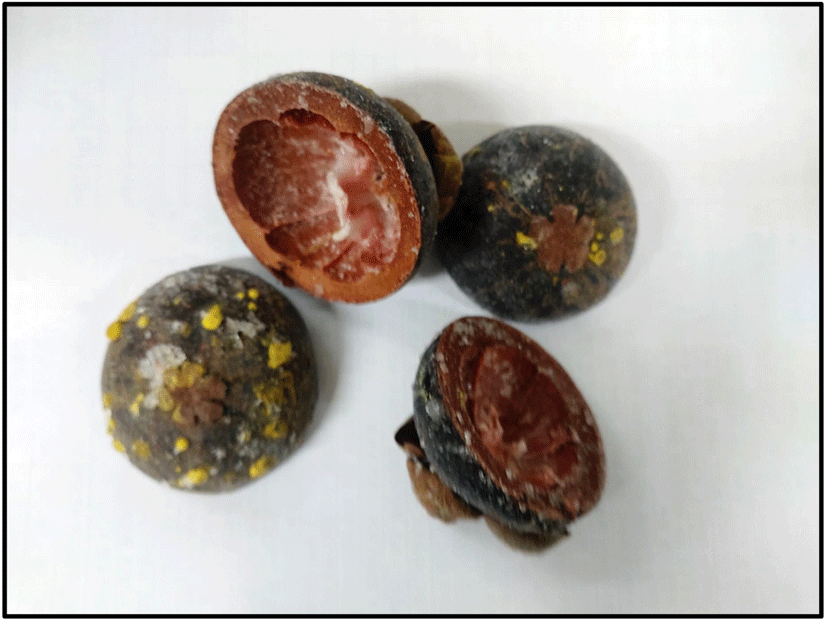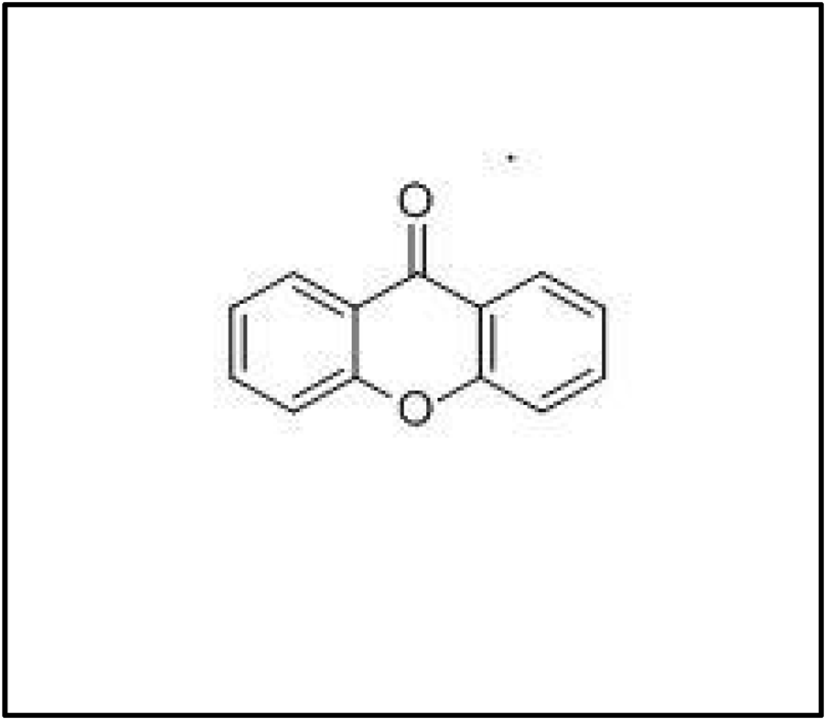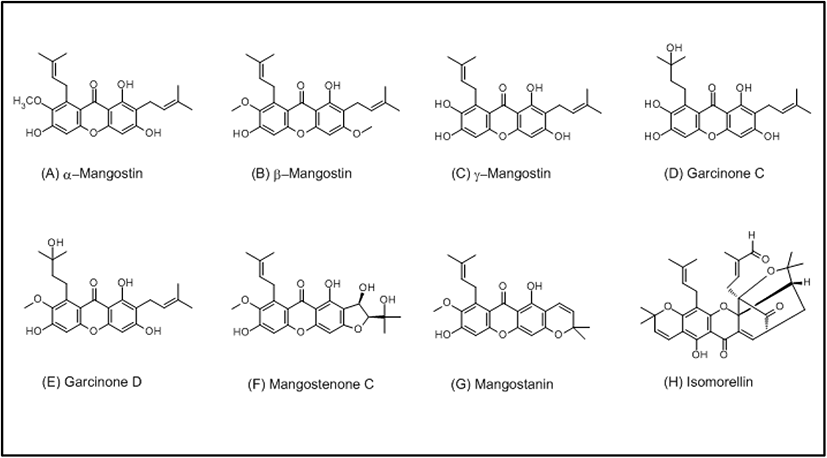Ⅰ. 서 론
망고스틴(Garcinia mangostana L.)은 대표적으로 태국, 말레이시아와 같은 동남아시아 지역에서 광범위하게 재배되고 있는 과일이다(Figure 1). 망고스틴은 함유되어 있는 xanthone에 의해 뛰어난 효과를 보인다고 보고되어지며 현재 60여 종이 알려져 있다(1). Xanthone은 anthraquinone과 관련된 자연 혹은 합성의 화합물로 망고스틴으로부터 추출되는 오르가닉 수지성분으로 생체대사활동의 필수인 cytochrome P450의 주요한 구성요소로 작용한다. 초기에는 유충을 죽이는 살충제 및 닭의 산란제로 이용되었으며, 최근에는 극소량으로 뛰어난 항산화효과, 항염, 항암효과, 피부보호 효과를 낸다고 밝혀졌다. Methicillin resistant Staphylococcus aureus(MRSA)와 vancomycin resistant Enterococci(VRE)와 같은 항생제 내성을 가진 세균들에게도 큰 항균효과를 가진다는 것이 알려져 있다(3). 이러한 xanthone을 자원의 재활용으로 버려지는 부분인 외피를 이용하여 순수 분리한 α-망고스틴(alpha-mangostin), β-망고스틴(beta-mangostin) 등을 이용하여 생산해 낼 수 있으며, 친환경적인 산업에 기여할 수 있다(1, 2). 본 연구에서는 화장품, 식품, 의류, 의학적인 산업에 기여할 수 있으며, 재활용 소재인 망고스틴의 과피를 이용하여 추출한 xanthones의 대표적인 종류들과 이용 및 추출방법에 대해 알아보고자 한다(Figure 2).
Ⅱ. 대표적인 크산톤의 종류와 효능
알파 망고스틴(alpha-mangostin)은 노란 색상을 나타내는 물질이며, 망고스틴에서 최초로 분리한 xanthone이다(Figure 3). 알파 망고스틴은 과피에서 28~37% 수준의 가장 많은 함유량을 보여주며 귀중한 약제로 분류가 된다(2). 효과로는 항산화, 항암, 항염 등의 생리학적 작용이 보고되어 있다(4). 이외에도 저밀도 지방 단백질(low-density lipoprotein, LDL)의 산화를 감소시키고, 상처 치유 등의 약재로 사용된다. 현재는 화장품 산업과 관련하여 인간각질형성세포의 분화에 미치는 영향의 연구, 인체적용시험 연구를 통한 화장료로써 다양한 분화로의 적용가능 여부가 탐구되어지고 있다(5).
Xanthone의 성분 중의 하나로 망고스틴의 과피, 줄기, 잎에 함유되어 있다. 말레이시아, 보르네오의 국가에서 발열, 기침, 설사, 가려움증, 궤양 및 복부 질환을 치료하는데 사용이 되는 성분이다(6). 최근의 연구에 따르면 암세포종의 백혈병(human leukemia)인 HL60, 대장암(colorectal cancer)의 DLD-1, HT-29 등에서도 효과를 보임이 밝혀졌다(2).
망고스틴의 과피로부터 얻을 수 있는 xanthone의 성분 중 하나이다. 과피에 알파 망고스틴에 비하여 많은 양이 함유되어 있지는 않지만 최근 연구로부터 신경세포의 산화적 손상 억제, 세포자멸사 억제, 베타-세크레타제 활성을 억제함이 밝혀졌다. 부작용이 적은 성분이며, 신경을 보호하고, Aβ펩타이드의 생성을 억제하는 효과가 우수하므로, 치매를 비롯한 퇴행성 뇌질환의 예방 또는 치료에 유용하게 사용된다(7).
망고스틴의 과피에서 확인된 천연 xanthone의 성분이며 유도체이다. 전통 한약제로써도 사용이 가능하며, 항염증, 진통제, 육아 성장촉진약으로도 사용이 된다. 최근에는 시험관내에서 MCF-7, A549, HEP-G2 및 인간 암세포주에 대해 세포독성을 나타내는 것으로 보고되었다(8).
망고스틴의 과피, 줄기 또는 잎에서 분리된 xanthone 유도체인 가르시논 D에 대한 효과는 잘 알리어지지 않았으나, C17.2 세포증식의 촉진, 세포주기의 분포 변경, STAT3/ Cylic D1경로의 영향을 미치는 것으로 최근에 보고가 되었다. T림프구성급성백혈병(T-lymphoblastic leukemia) 관련의 CEM-SS cell과 대장암(colorectal cancer) 관련 HT-29에도 효과를 나타낸다(2). 가르시논 D는 모든 세포주에서 일반적이지 않으며, 생체 내에서의 역할을 입증하기 위해 추가적인 연구가 계속되어지고 있다(9).
망고스틴의 과피에서 분리할 수 있으며, 폐암(lung cancer) 관련의 NCI-H187, 유방암(breast cancer) 관련 BC-1, 구강암(mouth epidermoid carcinoma) 관련의 KB cell에 효과를 보인다(2). 주로 암종에서 효과를 보이고 있으며, 자연 암치료제로 가장 효율적으로 사용된다(10).
열매의 과피나 나무 중심부에서 분리가 가능하다. 다양한 경로를 통해 암세포의 사멸에 기능을 하는 것으로 알려져 있으며, 트리터펜보다도 더 적은 양으로 암세포를 억제하는 결과를 보여주고 있다. 또한 궁극적으로 암세포의 전이로 인한 거대화를 막아내는 역할을 한다(11).
망고스틴의 과피에 함유된 xanthones으로 주로 세포주기 정지 및 세포자살(apoptosis)과 밀접한 관련이 있는 성분이다. CCA 세포주에서 세포자살(apoptosis)을 유도하며, 이는 아이소모렐린이 치료제로서의 역할을 할 수 있음을 보여주었다(12).
Ⅲ. 망고스틴 과피의 추출 방법 및 이용
일반적으로 망고스틴 과피 추출물은 과피를 분리 후 오븐에서 50~70°로 24시간 건조시키고, 추출 용매로는 주로 극성용매를 사용하며, 예로는 메탄올, 에탄올, n-프로판올, 2- 프로판올, n- 부탄올, 아세톤, 아세트산에틸 및 물이 사용될 수 있다. 용매가 특별히 한정되어 있지는 않지만 경구용 및 식품으로서 사용하는 것을 포함하여 고려한다면 추출 용매로써 물과 에탄올의 조합을 주로 사용한다. 에탄올과 물의 조합의 경우 70~95% 에탄올이 사용될 수 있다. 추출의 온도 또한 특별히 규정되어 있지는 않지만 실온 내지 용매의 비점 온도의 범위가 바람직하다. 신선품 또는 건조물, 분말 등 과피의 상태에 따라 추출의 시간이 달라지지만 0.5~24 시간의 범위가 바람직하다(13, 14). 추출물은 필요에 따라 농축을 하거나 용매 분획 및 크로마토그래피에 의해 정제하여 순수한 xanthone 성분들을 얻을 수 있으며, 동결건조를 동해 분말 형태로 제조 가능하다(Table 1). 이러한 추출물의 형태를 이용하여 xanthone 성분의 암세포 억제작용, 세포자살(apoptosis) 매커니즘, 세포주기 차단 메커니즘을 이해할 수 있으며, 더 나아가 화장품 원료로서의 여드름 치료제로도 사용이 가능하다(15–17).
Ⅳ. 결 론
현재 xanthone의 성분들은 다양한 연구분야에서 많은 효능들이 밝혀지고 있다. 암세포 억제작용, apoptosis 유도, 세포주기 차단 등의 의학적 분야와 식품 및 자외선 차단의 화장품 원료로써의 이용, 더 나아가 견적물의 염색에도 활용이 되는 의류산업에도 활용되어질 수 있다. 현재 많은 분야들에서 xanthone의 성분들 대신할 수 있는 인공적으로 만들어진 화합물들이 사용되어지고 있으나, 이것들은 인체 내에서 면역 반응을 일으킬 수 있는 부작용을 가지고 경제적으로도 많은 비용이 발생하게 된다. 이러한 문제들을 해결하기 위해서는 망고스틴의 과피와 같은 재활용 소재를 이용한 천연물에서 얻을 수 있는 xanthone의 다양한 성분들을 추출해야 하며, 보다 안정성에 관한 문제들을 보완하고 순도 및 수율을 높일 수 있는 추출방법들을 개발하여야 한다. 그러면 xanthone를 이용하는 응용산업 분야에서의 경제성과 인체에 보다 더 건강한 재료를 얻을 수 있으며, 현대 사회의 여러 가지 산업 분야에 이바지할 수 있을 것이다.









